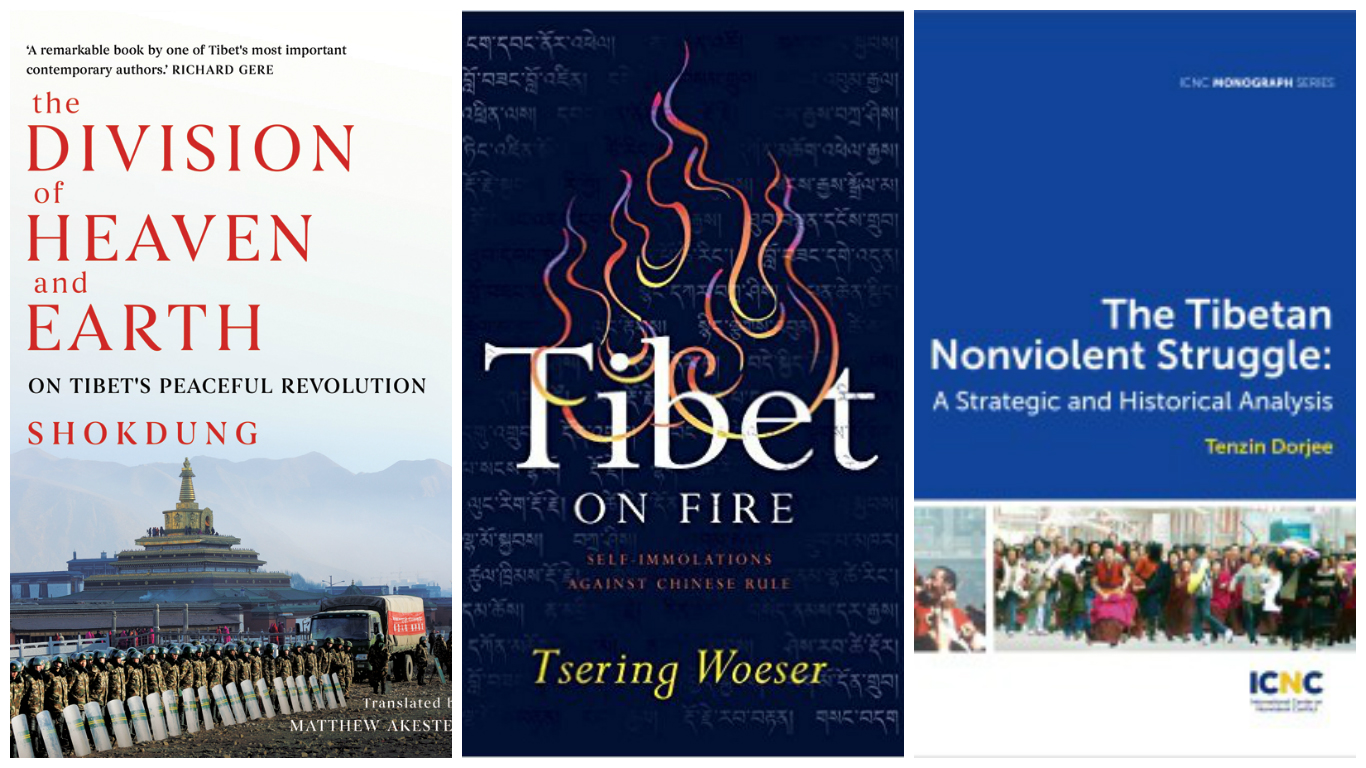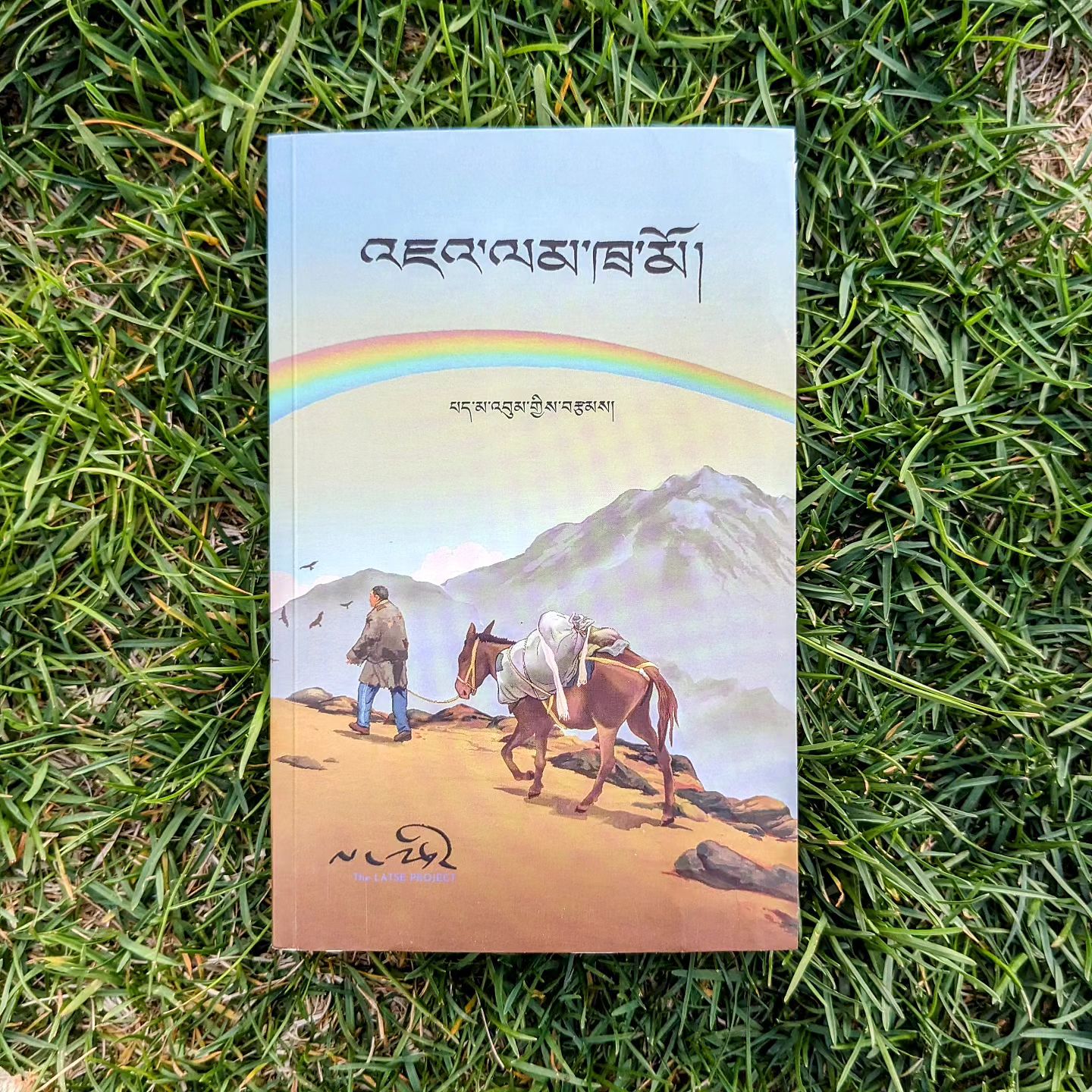High Peaks Pure Earth presents a guest post by Bhuchung D. Sonam in which he reviews three recent Tibet related books, “The Division of Heaven and Earth” by Shokdung, “Tibet on Fire” by Woeser and “The Tibet Nonviolent Struggle” by Tenzin Dorjee (Tendor).
All three books are works of non-fiction on the current situation in Tibet and have been featured on our Tibet Reading List. Bhuchung D. Sonam has identified common themes in the titles, such as nonviolent resistance, and the commentaries come from inside PRC (Woeser), Tibet (Shokdung) and exile (Tendor).
Our thanks to Bhuchung D. Sonam for submitting this review.
Gandhian Fire?
By Bhuchung D. Sonam
One grey morning, eight of us crammed in a taxi headed to the Dalai Lama’s temple for a special prayer session for Ani Sangye Dolma. She’d immolated herself on 25 November 2012. As the cab negotiated the sharp bends of the narrow mountain road, the six-year-old son of our neighbour said, ‘I will set myself on fire when I become eighteen.’ There was a dead silence. None of us could respond. A lump large as a yak arose in my throat. I gulped it down with a glob of tasteless saliva.
The scale of the Tibetan self-immolation and the circumstances under which these ongoing fiery acts are carried out is unparalleled in world history. In no struggle for freedom anywhere has there been so many people setting themselves on fire in so short a time as on the Tibetan Plateau; where over 150 people ignited themselves between February 2009 and November 2016. Despite such large-scale sacrifice the media coverage has been limited and concrete political response internationally has been negligible.
Perhaps because of these, and many other reasons, Tibet On Fire by Tsering Woeser becomes an important historical testimony on the causes of these fiery acts and the vicious response from the Chinese authorities. Woeser is a compelling chronicler of contemporary Tibet – her writing encompasses issues ranging from documenting ruins of ancient monasteries to the environment, culture and self-immolation. She convincingly argues that self-immolation – contrary to claims by mainstream opinion – is neither ‘suicide’ nor ‘an act of desperation’. It is ‘a sacrifice for a greater cause, and an attempt to press for change’.
Woeser asserts that it is the Chinese government and its policies, including systematic destruction of Tibet’s ecosystem, its punitive language regulations, mass Han migration and repression on religion among other measures that drive Tibetans to set themselves on fire. None of the self-immolators, who carried out the brave acts under an escape-proof security system with ‘nets on the sky and traps on the ground’, burnt themselves for personal reasons except two who self-immolated to protest against forced home-demolitions. As the acts were solely dedicated to benefit a greater collective cause, and devoid of self as in self-interest, self-benefit and self-glorification, the continued use of the term referring to these ‘singular acts of magnanimity is thus far more revealing of the poverty of the language than of the act itself,’ Woeser writes.
It is necessary here to focus on the power of the invisible – the strength of the mind and spirit that the State’s machineries cannot detect and destroy. This is the power to think, reflect and act – to act alone with no co-planners and co-doers. Both self-immolations and solo protests are manifestations of this invisible strength. These transcend extreme anxieties over being cornered with nowhere to retreat to. Particularly self-immolation is an audacious proclamation that while they do not have control over their lives they have power over their deaths – how they die and what to die for. This invisible strength is the ‘great courage’ Camus writes about ‘to gaze as squarely at light and at death’ and to choose a strategic place to perform the fiery acts despite total surveillance and presence of security personnel and the unknown number of spies embedded amongst the Tibetans.
In a land under occupation where everything is scripted from the top and each act is monitored, the only way out is bottom-up resistance. Self-immolation, solo-protest and the Lhakar Movement that emerged in the aftermath of 2008 Tibet-wide protests, embody the essence of nonviolent grassroots dissent giving voice to collective frustrations and aspirations. Tenzin Dorjee’s wonderful monograph The Tibetan Nonviolent Struggle: A Strategic and Historical Analysis deals with the entire spectrum of Tibetan resistance and protest since 1956 with particular focus on strategy and nonviolent tactics. Courage alone, he writes, ‘cannot compensate for lack of strategy’.
There is a trend within the Tibetan freedom movement to engage in ‘epic and dramatic’ tactics such as large-scale street protests and unto-death hunger strikes. A Tactical Report on the Tibet Movement, a study done by the International Tibet Network, reveals that street protests, marches and vigils are among the most common methods activists have employed. Consequently noncooperation tactics that are considered not-newsworthy and uninviting are often set a side despite the fact that Tibetans have used these tools in some areas inside Tibet to produce concrete results.
The dialogue process with Beijing is in deadlock as the Chinese side vehemently – and unswervingly – calling Dharamsala’s Middle Way Approach ‘an attempt to achieve Tibetan independence’. In the last few years we have seen a dwindling of global support for Tibet. Worse still, we are witnessing a crackdown on peaceful Tibetan protestors in free countries – the most recent case being in Switzerland in January 2017 where riot police forcefully detained over 30 activists. The Swiss government limited the protest time to just two hours for about 800 Swiss-Tibetans protesting against Xi Jinping who was attending the World Economic Forum in Davos.
Under these circumstances, the rise of homegrown grassroots nonviolent resistance is a fresh and positive development. This ‘transformative resistance’, as Dorjee terms it, is exemplified by the Lhakar Movement which focuses and stresses on the core of Tibetan identity. Tibetans waging a resilient peaceful resistance under an extremely repressive political system in Tibet is a fundamental shift in the discourse of Tibet’s freedom struggle ‘from one of victimhood to one that emphasises agency, creativity and strategy’.
Dorjee contends that Tibetans treat ‘nonviolence and resistance as two incompatible variables’ and that within their consciousness nonviolence is a concept that applies to ‘individual action in the moral dimension rather than collective action in the sociopolitical dimension’ as Gandhi championed and applied with a great degree of success in his activism against British rule in India. The unfailing focus on and promotion of ‘principled nonviolence’ – which the author describes as ‘the Dalai Lama’s moral and ethical commitment to nonviolent dialogue and mutual compromise’ – in the Tibetan struggle has ‘overshadowed the importance of maximising the impact of nonviolent action’. A dose of Gandhian active nonviolence, treating it as ‘a strategic weapon rather than merely a moral restraint’, is crucial.
Shokdung’s The Division of Heaven and Earth: On Tibet’s Peaceful Revolution, superbly translated by Matthew Akester, deals at great length about Gandhian nonviolent strategies and their applications in the Tibetan case.
Shokdung, who suffered incarceration after the publication of this book in Tibet, is a profound intellectual who is at ease quoting from the works of contemporary Tibetan writers such as Jamyang Kyi, Gartse Jigme and Theurang, as well as early Western philosophers like Socrates, Plato, Cicero and others. The Division of Heaven and Earth is divided into four sections: joy, sorrow, fear and lessons in the peaceful resolution.
The fourth section is significant in which he inquires into Gandhi’s Satyagraha (truth-insistence), civil disobedience and non-cooperation nonviolent strategies to find a way forward for Tibet’s freedom struggle. ‘If Tibetans reached a high level of religious development as a result of 1000 years of absorbing Indian religious culture,’ he writes, ‘now their absorption of Indian (Gandhian) political culture could result in their moment to win political rights.’ As much as Shokdung admires Gandhi’s nonviolent tactics, he clearly understands that the ground realities are different. He warns that totalitarian China is not British India, which had some ‘moral conscience’. As a result, Shokdung states that Indians were able to form ‘powerful political parties’ whereas Tibetans find it extremely difficult even to plan a street protest.
The confluence of these new titles is Tibet’s insistence on nonviolence and ways in which Tibetans on both sides of the Himalayan mountains can reinforce this unavoidable path. Whether it is not celebrating Losar, the Tibetan new year, or buying one’s groceries from a Tibetan-owned store, or speaking and dressing Tibetan each Wednesday to embrace Tibetan culture and reaffirm their identity, Tibetan people have a firm determination to ‘hold to the principle of nonviolence’. This strategy must be, Woeser writes, ‘enacted with care, planning, and the type of guidance that can make the broader population aware of its fundamental significance, inspiring further substantive action’.
To any Tibetan who may nurture even a tiny ember of fire to take the path of ‘retaliation and vengeance, out of desperation, using poison gas and explosives, and carrying out assassination and murders like terrorists’, Shokdung has a warning that these ‘will lead to the total destruction not just of intangible things like religion and culture, but of things as tangible as your own homeland ringed by snow mountains and ultimately of a whole people.’ Dorjee echoes a similar conclusion: ‘Time and again, any violent act by participants in a movement, no matter how limited and isolate, have benefitted the oppressor far more than the oppressed.’
Opting out on violence certainly does not mean accepting oppression which does not make it go away just as economic progress alone cannot make up for the dignity and freedom of a people living under occupation. The challenge for Tibetans, therefore, is to hold onto the nonviolent path but also to find creative strategies and tactical tools applicable in their everyday lives. Such daily practices can challenge the Chinese authorities and at the same time inculcate inter-generational culture of resistance that may last beyond this current static period. In the absence of any imaginative proposition from the exile government, and Beijing’s stubborn refusal to respond to Dharamsala’s overtures, grassroots strategic nonviolent actions may be Tibet’s hope for a brighter future.
Information:
Tibet On Fire: Self-immolation Against Chinese Rule by Tsering Woeser (Translated by Kevin Carrico)
Verso Books, 2016, $16.95
Order the book on Amazon here: http://amzn.to/1VWfsJ8
The Division of Heaven and Earth: On Tibet’s Peaceful Revolution by Shokdung (Translated by Matthew Akester)
Hurst Publishers, 2016, $14.99
Order the book on Amazon here: http://amzn.to/2gErYxL
The Tibetan Nonviolent Struggle: A Strategic and Historical Analysis by Tenzin Dorjee (Tendor)
International Centre on Nonviolent Conflict, 2016, $6.75
Download the published manuscript in English (1.8 MB pdf).
Download the published manuscript in Tibetan (4.1 MB pdf).
Order a hardcopy from Amazon: http://amzn.to/2aTMEor






Follow Us!